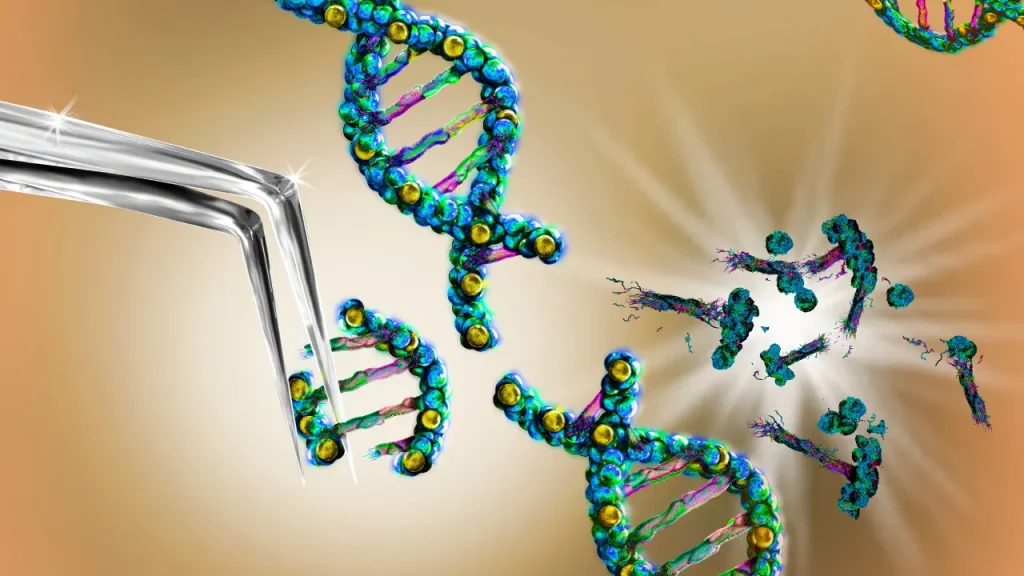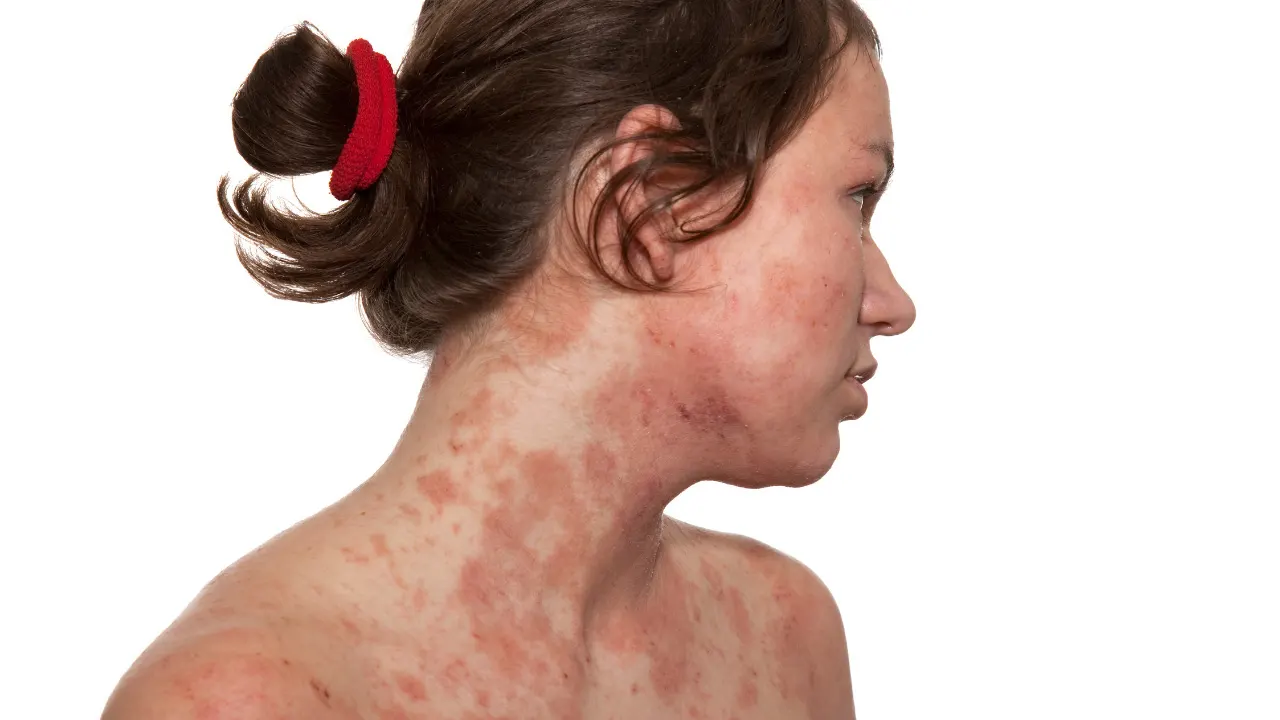Description
A small but significant illness known as autoimmune progesterone dermatitis (APD) affects mostly women and a specific population of people. It is distinguished by skin symptoms like hives, itching, rash, and in more severe cases, angioedema, and anaphylaxis. As progesterone levels fluctuate during pregnancy or the menstrual cycle, symptoms often appear first. The immune system wrongly views progesterone as an outside invader, leading to an inflammatory response in the skin, which is why APD is categorized as an autoimmune illnesses (similar to Lupus).
Although the precise mechanism underlying this autoimmune reaction is yet unknown, it is believed to be complex and to involve both hormone abnormalities and genetic predisposition. The skin symptoms range from minor erythema to serious, perhaps fatal reactions like anaphylaxis. Progesterone levels alter in a cyclical rhythm, and this coincides with the signs and symptoms of APD, which include: –
- Pruritus: A typical and upsetting symptom of APD for sufferers is intense itching.
- Skin Rash: One distinguishing sign of APD is a red, itchy rash. The rash can manifest as hives or urticaria featuring raised, crimson welts on one’s skin or as eczema-like regions featuring dry, scaly, and irritated skin.
- Urticaria (Hives): Hives can manifest as elevated, swollen, and light red lumps on the skin that itch often.
- Angioedema: Angioedema, a severe form of swelling underneath the skin’s surface that usually affects the lips, face, and throat, may occur in people with APD.
- Pregnancy-Related Flares: The increase in progesterone levels during pregnancy may make APD symptoms worse.
- Menstrual Flares: The days preceding menstruation, or the luteal stage of the menstrual cycle, are when many women having APD suffer an aggravation of symptoms.
You May Also Like:
5 GREAT WAYS TO REDUCE STRESS AND ELEVATE MOOD WITHOUT ALCOHOL
CONSTANTLY FEELING THE EFFECTS OF BURNOUT AND ANXIETY? LEARN ABOUT STRATEGIES FOR COPING WITH STRESS
Autoimmune Progesterone Dermatitis: Description, Causes, And Treatment Protocol is an original (HealthXWire) article.
Possible Causes
Autoimmune progesterone dermatitis (APD), which is regarded as a complex and uncommon illness, has an unidentified exact cause. Nevertheless, a number of probable reasons or contributors to the formation of APD have been suggested. These consist of: –
- Hormonal Fluctuations: APD is intimately related to hormonal changes, particularly shifts in progesterone levels. Skin reactions frequently happen when progesterone levels are high, like during pregnancy or the luteal stage of the cycle of menstruation. If you are are prone to these fluctuations, hormonal changes may set off or worsen the immunological reaction.
- Immune System Dysregulation: APD is categorized as an autoimmune disorder, which means that the immune system of the body incorrectly views its own tissues—regarding this instance, progesterone—as alien invaders. This starts an immunological reaction, which causes inflammation and skin responses.
- Genetic Predisposition: APD might be inherited, as some people may be predisposed to autoimmune diseases or have a certain genetic make-up that affects how their bodies react to progesterone.
- Sensitivity or Allergy to Progesterone Metabolites: According to certain theories, some people with APD can be allergic or sensitive to certain progesterone metabolites. The presence of these metabolites in the body may cause an immunological reaction that results in skin responses.
- Hormone Replacement Therapy and Hormonal Contraceptives: In those who are susceptible, the use of progesterone-containing HRT or hormonal contraception may increase the symptoms of APD. This might be because these drugs include more progesterone than usual.
- Interactions with Other Substances: Under rare circumstances, it is probable that the immunological response to progesterone will interact with other elements of the body and cause an inflammatory response on the skin.
- Other Underlying Conditions: Some underlying diseases, like ovarian cysts or polycystic ovary syndrome (PCOS), might result in hormonal changes and imbalances, which may help APD develop.

Exacerbating and Mitigating Factors
The development and extent associated with autoimmune progesterone dermatitis (APD) are significantly influenced by aggravating and mitigating variables. The primary aggravating and mitigating factors related to APD are listed below: –
Exacerbating Factors: –
- Hormonal Contraceptives: Some hormonal contraceptives, including contraceptive patches, progestin-only pills, progestin-containing intrauterine devices (IUDs), and contraceptive injections, might boost progesterone levels and exacerbate the symptoms of APD.
- Hormonal Fluctuations: Progesterone, the hormone that typically changes during the period of menstruation, is what causes APD to occur when levels are elevated. Fluctuations can happen during the luteal stage, just before menstruation, and while pregnant. These hormonal changes may enhance skin sensitivity and make APD symptoms worse.
- Hormone Replacement Therapy (HRT): If the treatment involves progesterone, women receiving HRT to treat menopausal symptoms may develop exacerbated APD symptoms.
- Polycystic Ovary Syndrome (PCOS): A hormonal condition called PCOS can lead to hormonal imbalances and irregular menstrual cycles. These hormonal imbalances may cause APD flare-ups in women with PCOS to be more frequent and acute.
- Stress: Hormone levels might be affected by stress and emotional turmoil, thereby worsening APD symptoms.
- Ovarian Cysts: APD symptoms can be brought on by ovarian cysts, which can alter progesterone levels and influence hormone production.
Mitigating Factors: –
- Estrogen-containing hormonal contraceptives: Combination oral contraceptives that contain both progesterone and estrogen help lessen the symptoms of APD because they offer greater hormonal stability than progestin-only regimens.
- Pregnancy and Breastfeeding: APD symptoms may lessen or even go into a brief remission during pregnancy since progesterone levels are reasonably steady during this time. The symptoms of APD may also be reduced by breastfeeding, which inhibits ovulation and hormone swings.
- Menopause: Hormone levels, such as progesterone, fall as menopause approaches. For some women, this can result in a decrease in APD symptoms.
- GnRH Agonists: APD symptoms may occasionally be reduced by gonadotropin-releasing hormone (GnRH) agonists, that inhibit ovarian activity and lower progesterone levels.
- Allergy Management: Finding and treating additional allergies or autoimmune disorders may lessen the immune system’s overall load and maybe relieve APD symptoms.
- Lifestyle Modifications: Known triggers should be avoided, stress should be controlled, and a healthy lifestyle should be adopted.
Standard Treatment Protocol
A multifaceted strategy is commonly used to treat autoimmune progesterone dermatitis (APD), with the goals of symptom relief, hormonal regulation, and immune response modulation. Depending on the patient’s unique circumstances and the intensity of their symptoms, the specific treatment approach may change. The following elements may be a part of the typical APD therapy protocol: –
Symptomatic Relief: These include: –
- Topical Corticosteroids
Itching and skin irritation can both be treated with topical corticosteroids that are mild to moderate, like hydrocortisone. These are usually used for brief periods of time to prevent any potential negative effects.
- Antihistamines
Antihistamines sold over-the-counter, including loratadine, cetirizine, or fexofenadine, may help in easing itching, hives, and various other allergic skin reactions brought on by the immunological response sparked by progesterone.
Hormonal Regulation: These include: –
- Gonadotropin-Releasing Hormone (GnRH) Agonists
GnRH agonists can be used when hormonal contraceptives are ineffective or unsuitable. These drugs function by lowering progesterone levels and ovarian function.
- Hormonal Contraceptives
Oral contraceptives with estrogen and progesterone mixed or specific progesterone receptor modulators may be administered. These may contribute to stabilizing the hormonal milieu and regulating menstrual cycle variations, which may lessen the severity of symptoms.
Immunosuppression: These include: –
- Immunomodulators
For those with refractory APD, medications like cyclosporine can be an option. To lessen the autoimmune reaction, these medications modify the immune system.
- Oral Corticosteroids
Prednisone or other short-course oral corticosteroids can be administered to inhibit the immune reaction and treat cutaneous symptoms in severe instances or during flare-ups. Owing to possible negative effects, prolonged corticosteroid use is often avoided.

Treatment Options
Several adjunct treatments and alternative therapy strategies may be taken into consideration along with the usual treatment protocol to improve the therapy for APD. These alternatives include: –
Nutritional Supplements: These include: –
- Vitamin D
According to certain research, vitamin D supplementation might have immunomodulatory benefits and may help control the immunological response in autoimmune illnesses, thereby lowering inflammation of the skin in APD.
- Omega-3 Fatty Acids
Omega-3 fatty acids, which are present within fish oil supplements and have anti-inflammatory characteristics, may help alleviate skin irritation and inflammation brought on by APD.
Natural Remedies: These include: –
- Chamomile
When applied to the affected area, chamomile tea or compresses with chamomile extract can reduce inflammation.
- Aloe Vera
Aloe vera gel applied topically may alleviate itchy, irritated skin. Its hydrating and anti-inflammatory qualities are natural.
Herbal Remedies: These include: –
- Licorice Root
Since licorice root has anti-inflammatory characteristics, licorice root extracts can help reduce skin itching and inflammation.
- Turmeric
The main ingredient in turmeric, curcumin, has strong immunomodulatory and anti-inflammatory properties. It may be advantageous to take turmeric supplements or apply topical turmeric formulations.
However, it is crucial to remember that, despite their possible advantages, adjunct treatments ought not to serve precedence over standard medical care. To create a specialized treatment plan catered to their particular requirements and medical history, people with APD must work closely with a trained healthcare provider. Further study is needed to determine the effectiveness and safety of alternate therapy for APD, and patients must consult with their doctor before beginning any new treatments. It is imperative to schedule routine follow-up visits with a healthcare professional to assess treatment outcomes and make any required modifications.

Conclusion
Autoimmune progesterone dermatitis presents as a unique and intricate illness predominantly affecting women, characterized by skin reactions triggered by progesterone fluctuations. These skin symptoms, ranging from itching and rash to severe angioedema and anaphylaxis, stem from an autoimmune response in which progesterone is mistakenly perceived as a foreign invader. While the exact mechanism remains elusive, hormonal imbalances, genetic predisposition, and sensitivity to progesterone metabolites are believed to contribute.
Managing APD requires you to have a thorough awareness of the what the sympotms are s well as how to treat them. If you believe you may be prone to or are currently experiencing APD, it’s imperative that you collaborate closely with your healthcare professional. With the right amount of vigiliance and proactivity, you’ll be able to curb any lasting drawbacks associated with APD through optimized treatment.

Additional resources for further reference
- https://dermnetnz.org/topics/autoimmune-progesterone-dermatitis
- https://www.medicalnewstoday.com/articles/autoimmune-progesterone-dermatitis-and-lupus
- https://autoimmune.org/disease-information/progesterone-dermatitis/#:~:text=Depending%20on%20the%20severity%2C%20treatment,surgical%20removal%20of%20the%20ovaries.
Important Note: The information contained in this article is for general informational purposes only, and should not be construed as health or medical advice, nor is it intended to diagnose, prevent, treat, or cure any disease or health condition. Before embarking on any diet, fitness regimen, or program of nutritional supplementation, it is advisable to consult your healthcare professional in order to determine its safety and probable efficacy in terms of your individual state of health.
Regarding Nutritional Supplements Or Other Non-Prescription Health Products: If any nutritional supplements or other non-prescription health products are mentioned in the foregoing article, any claims or statements made about them have not been evaluated by the U.S. Food and Drug Administration, and such nutritional supplements or other health products are not intended to diagnose, treat, cure, or prevent any disease.





